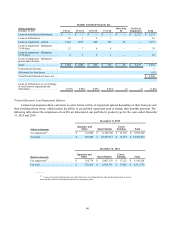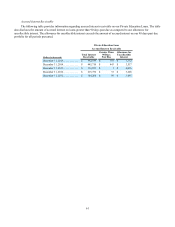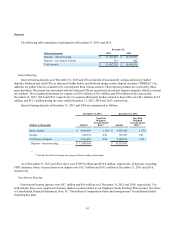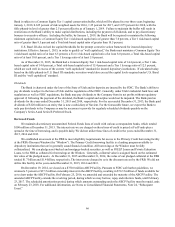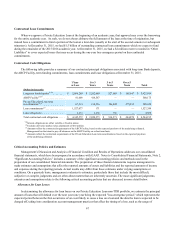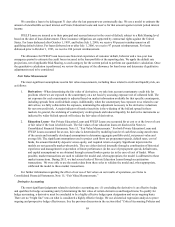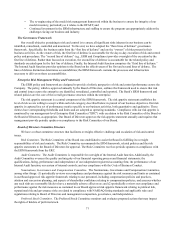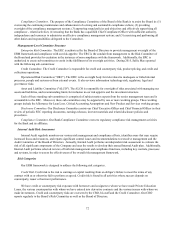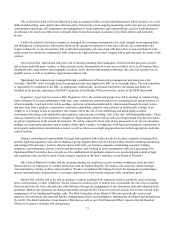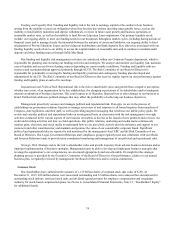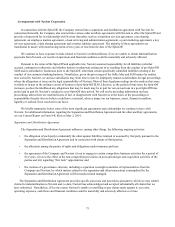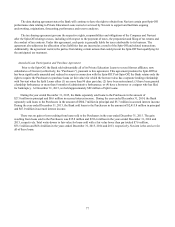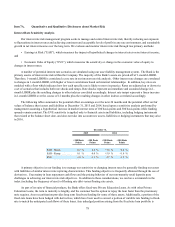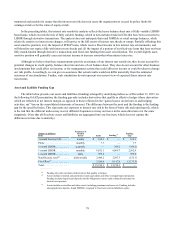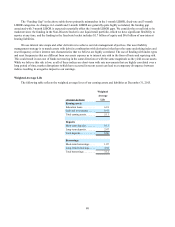Sallie Mae 2015 Annual Report Download - page 72
Download and view the complete annual report
Please find page 72 of the 2015 Sallie Mae annual report below. You can navigate through the pages in the report by either clicking on the pages listed below, or by using the keyword search tool below to find specific information within the annual report.70
Estimates — Fair Value Measurement” for significant judgments related to the valuation of derivatives. Although some of our
valuations are more judgmental than others, we compare the fair values of our derivatives that we calculate to those fair values
provided by our counterparties on a monthly basis. We view this as a critical control which helps validate these judgments. Any
significant differences with our counterparties are identified and resolved appropriately.
Transfers of Financial Assets and the Variable Interest Entity (“VIE”) Consolidation Model
We account for loan sales in accordance with the applicable accounting guidance. If a transfer of loans qualifies as a sale,
we derecognize the loan and recognize a gain or loss as the difference between the carry basis of the loan sold and liabilities
retained and the compensation received. We recognize the results of a transfer of loans based upon the settlement date of the
transaction.
If we have a variable interest in a VIE and we have determined that we are the primary beneficiary, then we will
consolidate the VIE. We are considered the primary beneficiary if we have both: (1) the power to direct the activities of the VIE
that most significantly impact the VIE’s economic performance and (2) the obligation to absorb losses or receive benefits of the
entity that could potentially be significant to the VIE. There can be considerable judgment as it relates to determining the
primary beneficiary of a VIE. There are no “bright line” tests. Rather, the assessment of who has the power to direct the
activities of the VIE that most significantly affect the VIE’s economic performance and who has the obligation to absorb losses
or receive benefits of the entity that could potentially be significant to the VIE can be very qualitative and judgmental in nature.
We have determined that as the sponsor and servicer of Sallie Mae securitization trusts, we meet the first primary beneficiary
criterion because we have the power to direct the activities of the VIE that most significantly impact the VIE’s economic
performance.
In 2015, we executed both secured financings and securitized loan sale transactions. Based upon our relationships with
these securitizations, we believe the consolidation assessment is straightforward. We consolidated our secured financing
transactions because either we did not meet the accounting criterion for sales treatment or we determined we were the primary
beneficiary of the VIE because we retained (a) the residual interest in the securitization and, therefore, had the obligation to
absorb losses or receive benefits of the entity that could potentially be significant to the VIE as well as (b) the power to direct
the activities of the VIE in our role as servicer. For those accounted for as securitized loan sales, we only retained servicing
and, therefore, are not the primary beneficiary because we have no obligation to absorb losses or receive benefits of the entity
that could potentially be significant to the VIE.
Risk Management
Our Approach
Risk is inherent in our business activities and the specialized lending industry we serve. The ability of management to
anticipate, identify and remediate risk in a timely manner is critical to our continued success. Our enterprise risk management
(“ERM”) framework is designed to identify, remediate, control and report these risks and escalate as appropriate to the Board of
Directors or its committees.
Risk Oversight
Our Board of Directors and its standing committees oversee our overall strategic direction, including establishing our
ERM framework. The Board also has oversight of the policy and procedures used for assessing the risks our businesses face as
well as the risk management processes developed and utilized by the management team. We have established a robust
framework to escalate to the Board any significant departures from the risk appetite statement in addition to any new and
emerging risks.
The Board of Directors, with senior management, took significant steps to continue the development of the ERM function
during 2015. Selected achievements included the following:
• Further embedding of the ERM program and its attendant policies, processes and infrastructure throughout the
organization.
• The launch of the Manager’s Assessment of Risk and Control, to provide a consistent methodology for risk self-
assessment across the enterprise;


